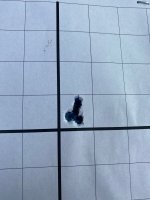I am reloading for a Bergara B14 HMR in 308. I am using Lapua Brass, 175 Grain Sierra Matchking BTHP bullets, and IMR 3031 powder (I prefer 4064 but this is what I was able to get my hands on recently). I am shooting off of a Caldwell Rock BR front rest with a Protektor rear bag. Last week I went to the range and I got the below groups, shooting at 100 yards (Please ignore the upper left group...I was shooting off of a bipod there...without a proper bag for the task...the results were horrible so I went with my rest for the other 3).
Anyway, I am obviously getting a lot of horizontal stringing and there wasn't a ton of wind the day I was shooting. I am wondering if anyone has any thoughts on how to reduce the horizontal.
My thoughts are:
Any thoughts/suggestions are welcome.

Anyway, I am obviously getting a lot of horizontal stringing and there wasn't a ton of wind the day I was shooting. I am wondering if anyone has any thoughts on how to reduce the horizontal.
My thoughts are:
- I was shooting off of wooden benches and noticed that my rear bag moved with recoil (due to the poor grip on the wood) and I had to reset it. I plan to design and 3d print a base for the bag to sit in. I will attach cleat spikes to the bottom and this should stop the bag from moving.
- I might try tweaking the seating depth a bit (though this was the start of a 15 thousandths node where the load I am shooting produced the smallest groups with this powder charge, so I have played with tuning seating depth. The seating depth (with the same powder charge) about 10 thousandths back (i.e. seated 10 thousandths deeper) produced a smaller more round group but it was basically a split group with 3 rounds touching and 2 above. 5 thousandths back from my current seating depth, I shot a group that actually had 4 touching and one low and right that ruined the group (I may have screwed up here ...4 of the shots were 0.36" C-T-C...The shot that was out of the group blew it up to 1.29"...So it's possible I may have canted the rifle on the shot that was way out of the group...).
Any thoughts/suggestions are welcome.


